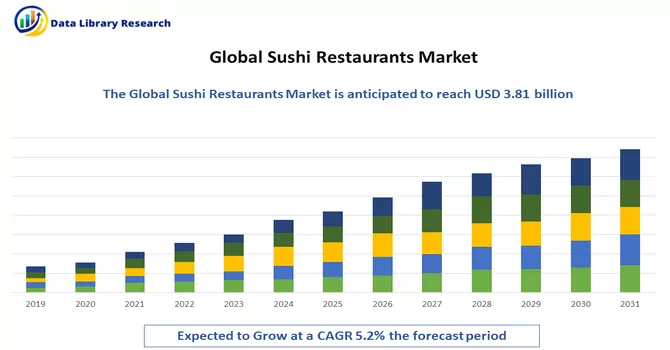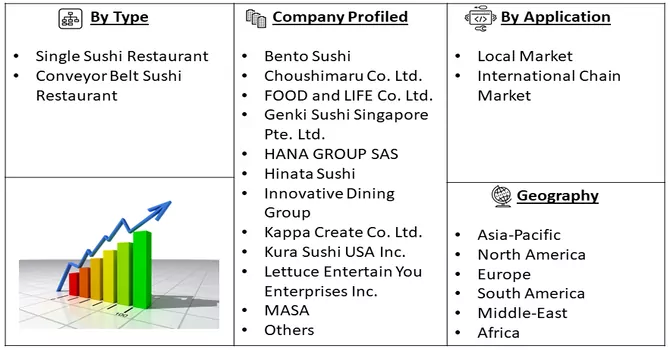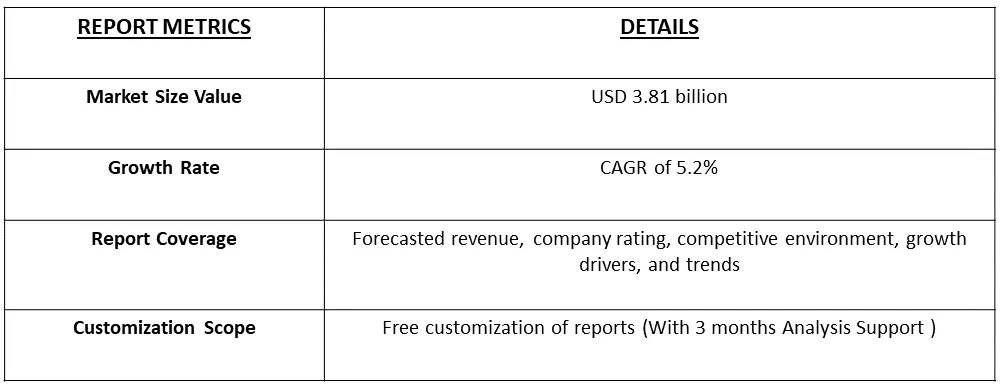The sushi industry continues to thrive as market analysts forecast significant growth, the market is currently valued at USD 3.81 billion and is expected to reach a CAGR of 5.2% over the forecast period (2024-2031).

Get Complete Analysis Of The Report - Download Free Sample PDF
Sushi is a traditional Japanese dish that typically consists of vinegared rice combined with various ingredients such as seafood, vegetables, and occasionally tropical fruits. The ingredients are often rolled inside a sheet of seaweed (nori) or served atop small beds of rice. Sushi can be presented in various forms, including sushi rolls (maki), hand-pressed sushi (nigiri), and layered sushi (sashimi). The dish is commonly accompanied by pickled ginger, wasabi (Japanese horseradish), and soy sauce for dipping.
The rise in international travel, globalization, and cultural exchange have exposed consumers to different gastronomic traditions, fostering an appreciation for Japanese cuisine, including sushi. The perception of sushi as a healthy and fresh food option, often incorporating high-quality seafood and vegetables, further propels its popularity in a health-conscious market. Additionally, the evolving consumer preferences toward convenient and ready-to-eat food options contribute to the success of sushi, as it is often available in quick-service formats. The sushi market is also influenced by the creativity and innovation of chefs and restaurateurs, who continually introduce new flavors, ingredients, and presentation styles, catering to the evolving tastes of consumers. As a result, the combination of cultural acceptance, health considerations, convenience, and culinary innovation collectively drives the growth and sustainability of the sushi market globally.
Market Segmentation: The Sushi Restaurant Market is Segmented by Type (Single Sushi Restaurant, and Conveyor Belt Sushi Restaurant), Application (Local Market, and International Chain Market) and Geography (North America, Asia-Pacific, Europe, South America, Middle East, and Africa). The market size and demand forecasts for the pump market in revenue (USD billion) for all the above segments.

For Detailed Market Segmentation - Download Free Sample PDF
The sushi market is undergoing dynamic changes driven by evolving consumer preferences and industry innovations. Notably, there is a growing trend towards plant-based sushi options as consumers embrace vegetarian and vegan diets, and sustainability becomes a key focus with an emphasis on responsible sourcing of seafood. Fusion and cross-cultural influences are reshaping the traditional sushi landscape, leading to innovative flavor combinations that cater to diverse tastes. Customization and personalization are on the rise, allowing consumers to build their own sushi rolls for a more interactive dining experience. Technology integration, including online ordering platforms and automated sushi-making machines, enhances convenience and engagement. Health-conscious consumers are drawn to sushi for its perceived nutritional benefits, while ready-to-eat and grab-and-go formats respond to the demand for convenient meal solutions. Creative presentation and aesthetic appeal, coupled with educational dining experiences, contribute to the visual and cultural aspects of sushi consumption. Additionally, the emergence of virtual and ghost kitchens reflects changing consumer habits, and the market continues to thrive on culinary creativity and the exploration of new culinary frontiers.
Market Drivers:
Increasing Emphasis on Healthy Eating, Sushi is Perceived as a Nutritious Option
As the focus on adopting healthy eating habits continues to grow, sushi has emerged as a widely regarded nutritious dining choice. The incorporation of fresh fish, vegetables, and rice in sushi not only resonates with but also actively addresses consumer preferences for balanced and health-conscious food options. This alignment with health-centric choices positions sushi as a favoured selection among individuals seeking a combination of culinary delight and nutritional benefits. The use of premium, high-quality ingredients in sushi not only caters to the demand for fresh and wholesome food but also underscores its appeal as a holistic and health-positive culinary option, contributing to its sustained popularity in the evolving landscape of dietary preferences. Thus, such factors are expected to witness significant growth over the forecast period.
An Increasingly Knowledgeable and Adventurous Consumer Base
A consumer base that is becoming progressively more informed and adventurous actively seeks distinctive and authentic culinary experiences. These consumers possess a heightened awareness of the diverse range of sushi varieties, intricate preparation techniques, and nuanced regional characteristics. This growing knowledge and curiosity among consumers play a pivotal role in propelling the market forward, contributing significantly to its expansion. As individuals continue to seek out unique and genuine gastronomic encounters, their increased understanding of the intricacies of sushi further amplifies its popularity, shaping the evolving landscape of culinary preferences. Thus, such factors are expected to witness significant growth over the forecast period.
Market Restraints:
Supply Chain Challenges
Maintaining a reliable and top-tier supply of fresh ingredients, especially premium seafood, poses considerable challenges within the sushi market. The availability and cost of essential sushi ingredients are susceptible to various factors, including overfishing, environmental concerns, and disruptions in the supply chain. Overfishing practices can deplete seafood resources, leading to fluctuations in the availability of key ingredients. Environmental issues, such as climate change and habitat degradation, further contribute to the unpredictability of sourcing high-quality seafood. Additionally, supply chain disruptions, whether caused by global events or logistical challenges, can impact the timely delivery and overall accessibility of fresh ingredients. These multifaceted challenges underscore the need for sustainable sourcing practices, proactive environmental stewardship, and resilient supply chain management within the sushi industry to ensure a consistent and quality culinary experience for consumers. Thus, such factors are expected to witness significant growth over the forecast period.
The COVID-19 pandemic has left an indelible mark on sushi restaurants, ushering in a wave of challenges and transformations. Government-mandated lockdowns and social distancing measures forced many sushi establishments to temporarily shutter their doors, leading to financial strain and operational disruptions. To cope with dine-in restrictions, a significant shift towards takeout and delivery services ensued, demanding adjustments in packaging, logistics, and marketing strategies. Supply chain disruptions posed difficulties in sourcing fresh and premium seafood, impacting the availability and cost of key sushi ingredients. Consumer confidence in dining out waned due to health concerns, prompting a hesitancy towards consuming raw seafood. In response, sushi restaurants adopted technology solutions, including online ordering systems and contactless payments, to enhance safety measures. The economic fallout resulted in financial strain and closures for some establishments, while others embraced hygiene protocols, digital menus, and catering adaptations to navigate the evolving landscape. Despite ongoing recovery challenges, the sushi industry continues to adapt, emphasizing safety, technological innovation, and strategic adjustments to meet the changing preferences of consumers in a post-pandemic era.
Segmental Analysis:
Single Sushi Restaurant Segment is Expected to Witness Significant Growth Over the Forecast Period
A singular sushi restaurant stands as a culinary haven, embodying the artistry and precision of Japanese cuisine in a single dining space. Each such establishment, meticulously crafted and designed, serves as a testament to the gastronomic mastery that sushi demands. These restaurants offer an immersive experience, where patrons are not merely diners but participants in an intricate dance of flavors, textures, and cultural richness. From the minimalist elegance of the decor to the expertly crafted sushi bar, the ambiance of a single sushi restaurant is curated to elevate the dining experience. The menu, a reflection of the chef's expertise, showcases a diverse array of sushi creations, from traditional nigiri and sashimi to innovative rolls that push the boundaries of culinary creativity. In this singular space, the chef's expertise is on display as they artfully prepare each dish, emphasizing the precision and skill integral to the sushi-making process. Whether nestled in a bustling city or a serene corner, a single sushi restaurant embodies the essence of Japanese culinary tradition, inviting patrons to savor not just a meal but an exploration of culture and craftsmanship.
International Chain Market Segment is Expected to Witness Significant Growth Over the Forecast Period
An international chain within the sushi market represents a global amalgamation of Japanese culinary artistry and diverse cultural influences. These chains, spanning continents and countries, bring the sophistication of sushi to a worldwide audience, catering to the diverse palates and preferences of patrons across borders. Renowned for their consistency in quality and adherence to traditional sushi techniques, international sushi chains offer a standardized yet adaptable menu that reflects both authenticity and innovation. The global presence of these chains is marked by a commitment to sourcing premium ingredients, ensuring that the essence of each dish remains true to its Japanese roots. With a network of restaurants strategically positioned in major cities and culinary hubs, these international chains contribute to the globalization of sushi, introducing the delicacy to new audiences and fostering an appreciation for this iconic cuisine on a global scale. The success of such chains lies in their ability to balance cultural authenticity with the adaptability necessary to cater to diverse tastes, making them key players in the worldwide popularity and accessibility of sushi.
North America Region is Expected to Witness Significant Growth Over the Forecast Period
In North America, the sushi restaurant market has undergone a transformative journey, witnessing a surge in popularity that transcends cultural boundaries. From quaint local sushi establishments to sophisticated sushi bars, the culinary landscape is teeming with diverse offerings, blending traditional Japanese techniques with innovative, fusion-inspired creations. Sushi has become a mainstream dining choice, with urban centers serving as hubs of vibrant sushi scenes catering to a broad spectrum of tastes. The North American palate has embraced not only classic nigiri and sashimi but also creative rolls that showcase culinary ingenuity. The emphasis on fresh, high-quality ingredients aligns with the region's penchant for premium dining experiences. Beyond major cities, sushi's influence has permeated suburban and rural communities, making it a universally loved cuisine. Sustainability and responsible sourcing have gained prominence, reflecting the region's commitment to ethical dining practices. The integration of technology, including online ordering and digital menus, has further enhanced the convenience and accessibility of the sushi experience. In essence, the North American sushi restaurant market is characterized by its diversity, adaptability, and the seamless incorporation of Japanese culinary traditions into the rich tapestry of the continent's culinary landscape. The continued growth and popularity of sushi in North America underscore its enduring appeal and its capacity to evolve in harmony with the dynamic preferences of the region's discerning diners. Thus, these factors are expected to drive the growth of the studied market in the region over the forecast period.

Get Complete Analysis Of The Report - Download Free Sample PDF
The competitive landscape of the sushi restaurant market offers comprehensive insights into each competitor. This encompasses a detailed analysis of the company, covering aspects such as its overview, financial standing, revenue generation, market potential, investments in research and development, initiatives in new markets, global reach, production sites and facilities, production capacities, as well as an evaluation of the company's strengths and weaknesses. Additionally, the assessment delves into product-related aspects, including recent launches, the breadth of product offerings, and dominance in specific applications. This in-depth exploration aims to provide a thorough understanding of each competitor's position within the sushi restaurant market, offering stakeholders valuable insights for strategic decision-making. A selection of companies mentioned in this report includes.
Recent Developments:
1) In June 2023, FOOD & LIFE COMPANIES Ltd. unveiled a new establishment within the "Sushi Sake Sakana Sugitama" brand at JR Noda Station in Fukushima-ku, Osaka.
2) In May 2023, another addition to the "Sushi Sake Sakana Sugitama" portfolio emerged in Minami Gyotoku, situated in Ichikawa City, Chiba Prefecture. These expansions reflect the company's strategic efforts to introduce its culinary offerings to diverse locations, catering to a broad audience under the esteemed "Sushi Sake Sakana Sugitama" brand.
Q1. What is the current Sushi Restaurants Market size?
The Sushi Restaurants market is currently valued at USD 3.81 billion.
Q2. At what CAGR is the market projected to grow within the forecast period?
Sushi Restaurants Market is expected to reach a CAGR of 5.2% over the forecast period.
Q3. What are the factors driving the Sushi Restaurants market?
Key factors that are driving the growth include the Increasing Emphasis on Healthy Eating, Sushi is Perceived as a Nutritious Option and An Increasingly Knowledgeable and Adventurous Consumer Base.
Q4. Which region has the largest share of the Sushi Restaurants market? What are the largest region's market size and growth rate?
North America has the largest share of the market. For detailed insights on the largest region's market size and growth rate request a sample here.
Data Library Research are conducted by industry experts who offer insight on industry structure, market segmentations technology assessment and competitive landscape (CL), and penetration, as well as on emerging trends. Their analysis is based on primary interviews (~ 80%) and secondary research (~ 20%) as well as years of professional expertise in their respective industries. Adding to this, by analysing historical trends and current market positions, our analysts predict where the market will be headed for the next five years. Furthermore, the varying trends of segment & categories geographically presented are also studied and the estimated based on the primary & secondary research.
In this particular report from the supply side Data Library Research has conducted primary surveys (interviews) with the key level executives (VP, CEO’s, Marketing Director, Business Development Manager and SOFT) of the companies that active & prominent as well as the midsized organization
FIGURE 1: DLR RESEARH PROCESS

Extensive primary research was conducted to gain a deeper insight of the market and industry performance. The analysis is based on both primary and secondary research as well as years of professional expertise in the respective industries.
In addition to analysing current and historical trends, our analysts predict where the market is headed over the next five years.
It varies by segment for these categories geographically presented in the list of market tables. Speaking about this particular report we have conducted primary surveys (interviews) with the key level executives (VP, CEO’s, Marketing Director, Business Development Manager and many more) of the major players active in the market.
Secondary ResearchSecondary research was mainly used to collect and identify information useful for the extensive, technical, market-oriented, and Friend’s study of the Global Extra Neutral Alcohol. It was also used to obtain key information about major players, market classification and segmentation according to the industry trends, geographical markets, and developments related to the market and technology perspectives. For this study, analysts have gathered information from various credible sources, such as annual reports, sec filings, journals, white papers, SOFT presentations, and company web sites.
Market Size EstimationBoth, top-down and bottom-up approaches were used to estimate and validate the size of the Global market and to estimate the size of various other dependent submarkets in the overall Extra Neutral Alcohol. The key players in the market were identified through secondary research and their market contributions in the respective geographies were determined through primary and secondary research.
Forecast Model
